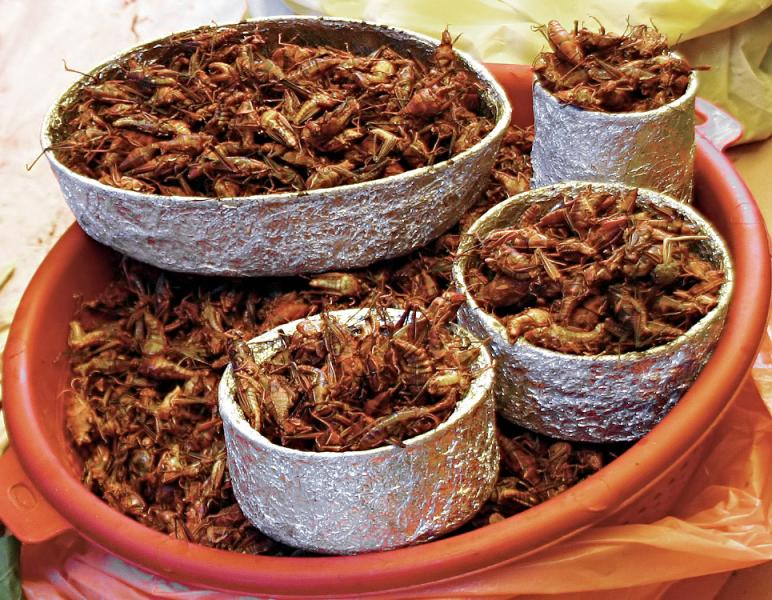Will America Embrace Insect Eating?

America has been slow to embrace this idea which has already been adapted by 2 billion people in the world. Los Angeles has a few locations that offer insects, but even their owners are cautious as to whether entomophagy will catch on.
Why America Should Start Eating Insects:
The FAO has sighted insects as having high feed conversion rate (an animal's capacity to convert feed into increased body mass). For the same amount of food per pound, crickets require 1.7kg of feed to 10kg for beef. In addition, most of an insect is edible whereas bones in larger animals are not.
The conversion rate can also be represented in water use and energy use. George Watland at the Sierra Club explains that, to produce one gram of beef protein requires 15.8 gallons of water compared to the .8 gallons of water required for one gram of cricket protein.
Insects are also an important source of nutrition. Crickets may be unappetizing to most, but Watland thinks that this important source of protein would be better if incorporated into food processing, similar to how seaweed like Carrageenan is extracted to provide a natural gel and thickener in food.
Finally, insects are a superfood due to their high concentration of vitamin and minerals. Silkworm chitin shells are great sources of fiber. Roasted turantulas in Cambodia are reported to be high in zinc. Fried caterpillars in Africa are packed with iron.
One major argument in favour of entomophagy is the low carbon gas emissions caused from raising them. Jessica Mariglio from the Association for Climate Education explains that livestock emissions contribute significantly to greenhouse gases.
However, current agricultural practices emphasize the use of corn to feed livestock. Farming and producing corn creates vast amounts of greenhouse gases. Likewise the use of centralized pastoral farming requires fossil fuels to transport meat. Insects, which produce negligible greenhouse gases by comparison can be easily raised at home and would bypass transportation emissions that other protein sources require.
One factor that has not been well studied in entomophagy is animal welfare concerns. Risa Lopez, manager at Guelaguetza restaurant, presents a dish of fried grasshoppers and wonders whether eating them can even be considered as meat.
The economics of entomaphagy is palpable. Lopez remembers walking through her native Oaxaca seeing women with baskets full of grasshoppers making a living through selling them as food. Watlands has researched the economic benefits of insect rearing and notes how they require minimal space to raise. In addition, they can be raised on organic side streams like human food waste.
Why America Isn't:
The economic model of raising insects for food seems to only have one obstacle: People are generally disgusted by the thought of eating insects.
Even James On, who manages the restaurant Mok Karu serving dishes of sea snails and silk worm coccoons, think that eating insects is merely a novelty, and could never catch on in mainstream cuisine.
Lopez is one of the 2 billion people in the world that has insects as part of her weekly diet but says "I think people should try new things. But am I going to stop eating meat and sustain an all bug diet. Highly unlikely."
Mariglio points out why Americans will be hesitant in adopting entomophagy. She quotes George Bush during his refusal to ratify the Kyoto Protocol "We will not sacrifice the American way of life." Marigilio thinks that a lot of Americans will agree with the former president and eschew something radical and foreign like entomophagy.
Nevertheless, in 19th century America, the feeding of lobster to prisoners twice a week was considered a cruel and inhumane punishment. The transformation of lobsters being taboo to being one of the most prized foods in the world demonstrates how America's palate can change.
Watland believes that the American adoption of entomophagy can occur in a couple of decades, and will first take place when people who already eat insects introduce it to their American friends.



